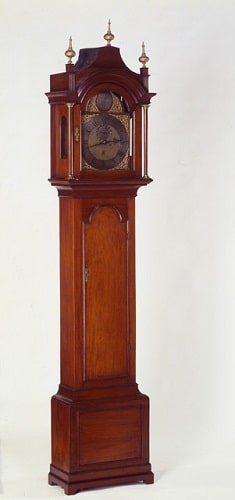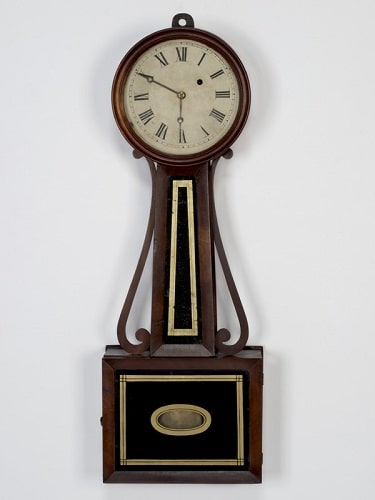“Clockmakers and Collectors” at the Scottish Rite Masonic Museum & Library
by Hilary Anderson Stelling
Director of Exhibitions and Audience Development
Scottish Rite Masonic Museum and Library
A Generous Legacy
In the face of fast-paced change in the early 1900s, many Americans sought to celebrate past ingenuity and seemingly simpler times through collecting antiques. A similar impulse may have influenced Willis Michael (1896-1969), a tool and die maker, to start his collection of antique American and European clocks. Michael purchased his first one in the late 1930s, a tall case clock crafted in the late 1700s by John George Hoff (1733ñ1816) of Lancaster, Pennsylvania or his son, also John George Hoff (1788 – 1822). Michael soon, as he later said, “got the bug” and his collection grew. Many of the clocks on view “In Keeping Time: Clockmakers and Collectors” at the Scottish Rite Masonic Museum & Library in Lexington, Massachusetts, come from the collection of Willis Michael and his wife, Ruth Michael (1925-1982). After Mr. Michael died, Ruth Michael began making a series of gifts to the Museum, then newly founded by the Scottish Rite Masons of the Northern Masonic Jurisdiction. She did so in honor of her husband’s lifelong involvement in Masonry and the many friendships he had made through his participation. Mrs. Michaels’ gift of over 140 pieces from her husband’s collection forms the core of the Museum’s timepiece holdings. Other collectors, families and craftsmen have donated to the Museum’s clock and watch collection over the years – It now numbers in the hundreds.
Clockmaking AND Apprenticeship
Learning how to make clocks required knowledge of metals, mechanics and math. Clockmakers, like Benjamin Willard (1743-1803) who, as a young man, made this tall case clock in Lexington, Massachusetts, constructed the works – the gears, pins, plates and other parts that allow clocks to operate. Often working with fellow craftsmen like cabinetmakers, engravers and painters, clockmakers assembled multiple elements to give their clients finished, working timepiece. In addition to constructing new clocks, makers earned their living by cleaning and repairing old ones.
To learn the craft, a youngster apprenticed with an experienced maker. Apprentices committed years of their labor in exchange for room, board, instruction and experience. Learning from an experienced clockmaker, apprentices were instructed, in some part, as their teachers’ had been taught, so traditional methods of manufacturing and repairing clocks lived on through generations. Through performing tasks in the shop and observing the master clockmaker and his employees, an apprentice learned how clocks operated, how to cut gears, how to put together clockworks and how to conduct a business. Some continued to work for their masters as paid journeymen after their formal apprenticeship ended. Nathanial Mulliken (1722-1767) of Lexington, Massachusetts, is thought to have trained Benjamin Willard – but not for long. Only a year into Willard’s apprenticeship, Mulliken died. Willard stayed in Lexington for four years to make clocks, like this one, with Mulliken’s teenaged son. Willard crafted over 20 clocks per year at different locations in Massachusetts before scarce metal supplies and an uncertain economy disrupted his work. He also played a role in training his now well-known brothers, Simon (1753-1848) and Aaron (1757-1844), in the clockmaking trade.
In the 1700s and early 1800s, the apprenticeship system shaped the clockmaking craft. In spite of this traditional system, inventive clockmakers found new ways to improve their products and expand their share of the market. Like others working in the early 1800s, Simon and Aaron Willard brought innovation to the clockmaking business. They introduced new efficiencies in clock production, such as standardized designs and parts. They also drew on a rich network specialized artisans to undertake certain tasks, like cabinetry, gilding or other decoration. This helped lower their costs without diminishing their offerings’ quality or attractiveness. Their fashionable, accurate tall case clocks cost $50 – $60. This price range, comparable to six month’s wages for a farm worker, though out of reach for many, was attractive consumers with money to spend.
Innovation in the early 1800s
In an effort to make a small and efficient yet stylish wall clock, Simon Willard first patented a distinctive shape of clock – now called banjo clocks – in the early 1800s. His patent expired in the 1830s. Before then and after, other clockmakers provided consumers with banjo clocks, with and without Willard’s permission. With continually updated styling and increasingly affordable prices, banjo clocks remained popular with consumers throughout the 1800s. Massachusetts maker Horace Tifft (1804-1886) produced banjo-shaped clocks in volume from the mid-1840s through at least 1861, promoting his work in showrooms he established in New York and Philadelphia.
In the 1820s, Americans, unlike Europeans, did not manufacture the good quality coiled steel springs used to power small clock mechanisms. Clockmaker Joseph Ives (1782-1862) developed a different kind of clock spring that was easier to make, a miniature version of the springs used in wagons. The firm Birge and Fuller acquired Ives’ business in the 1830s, including his patents. For several years, they made fashionable, gothic-style clocks, like this one, powered by Ives’ innovative springs.
Choice Explosion
From the mid-1800s on, fueled by innovation, increasing interest in clocks and industry-wide competition, consumers enjoyed many choices in factory-produced clocks. Different makers produced a wonderful variety of clocks and sold them at a range prices to appeal to every taste and budget. Clockmakers also offered novel features to help their offerings stand out in the marketplace. For example, in the early 1900s, merchant and inventor Eugene Fitch (1846ñca. 1915) sought patents for a “time indicator” that showed hours and minutes on cards, or plates, rather than on a dial. The Ansonia Clock Company manufactured Fitch’s Plato Clock, named after the plates that showed the time, from 1904 to 1906. Afterwards, the design lived on in Europe. Companies there sold variations of the Plato Clock through 1914. In another example of an attention-getting design, an unknown maker manufactured this small horseshoe-shaped clock with a glass face. In the 1700s and 1800s, clocks that struck the half hour or hour helped people know the time during the night, even when they could not see a clock face. This glass and metal clock, made in the mid-1800s, solved the problem in a different way. Designers at the Ansonia Clock Company crafted this clock to be lit from behind. When the glass face was illuminated, the dark numbers and hands on the clock’s opaque glass could be seen after the sun went down.
A Passion for Clocks
Against the backdrop of a profusion of factory-produced clocks, some clockmakers took a different approach; they crafted creative and expressive clocks one-by-one. Although it is not known if W. H. Mackenzie (dates unknown) made or received this personalized clock as a gift, its adornment with symbols related to Freemasonry and Odd Fellowship speak to his association with these groups. Demonstrating his creativity, the maker of this clock incorporated a round metal clock, originally designed for use in a car, into this decorative object. He used a wooden crate, originally for evaporated milk, as the foundation to which he attached carved wood ornaments. With his employment of bold carving and found materials, this clockmaker crafted a piece of folk art that also told the time.
Imagination and a love of making things shaped George McFadden’s life. During his long career, he designed sets and costumes for the theater and crafted jewelry. He also created mechanized displays for department stores and circus acts. In retirement McFadden, who lived in Winchester, Massachusetts, dug into his passion for clocks, especially cuckoo clocks. His neighbors and other clock enthusiasts brought him timepieces for repair. This paper mock-up shows an idea McFadden had for a sign to advertise his business.
Every year McFadden made a clock for his own pleasure, each designed around a theme, using reconditioned parts from old timepieces for works. The pictured clock tells McFadden’s version of the story of Jonah and the Whale. When this clock was animated, the waves of the ocean rolled and the whale swallowed Jonah. In crafting this and other whimsical clocks, McFadden put his energy into their charm, shape and color and the narrative he wanted to explore. As they tell their stories, McFadden’s clocks also speak to their maker’s creativity and sense of humor.
These clockmakers and more are represented at Keeping Time. We hope you will have a chance to come visit the exhibition between now and October 29, 2016. For more information on the Scottish Rite Masonic Museum & Library’s exhibition, programs and collections, visit monh.org.





Related posts: